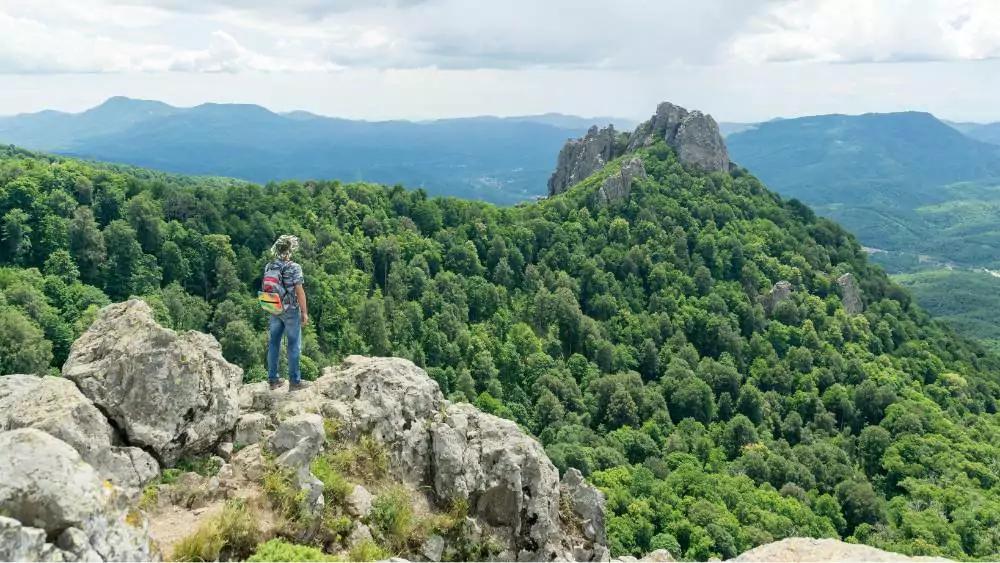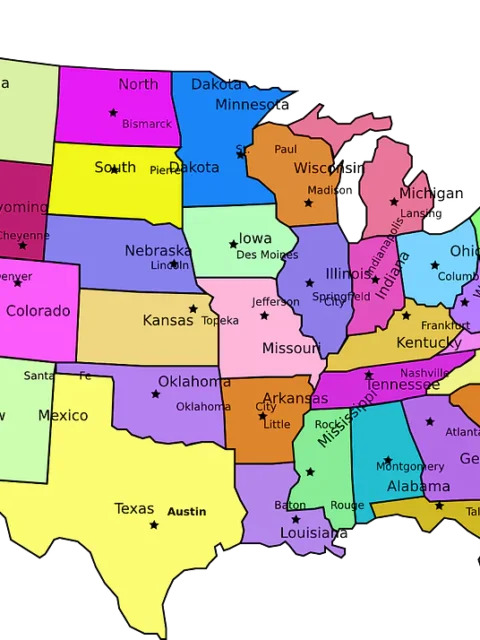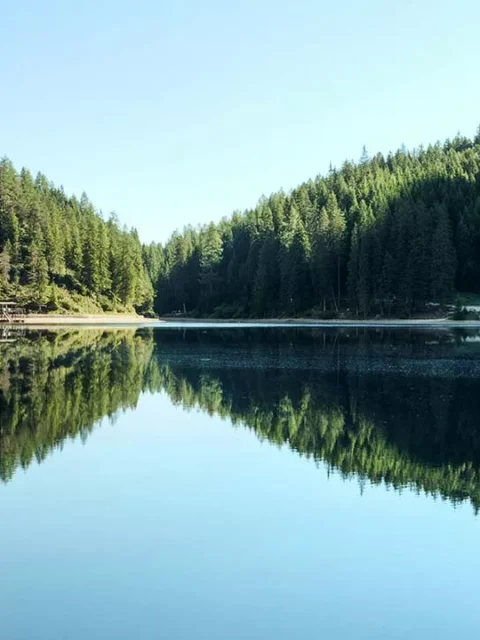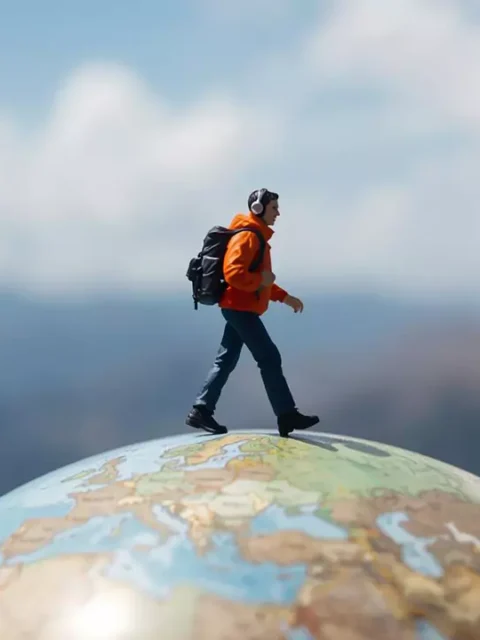From Destinations to Gears – An Ultimate Guide for a Memorable Solo Hiking Journey!

A woman, arms raised in triumph at the edge of a canyon with a breathtaking view. A smiling man, hiking poles in hand, making his way up a ruggedly beautiful trail. Open any social media app and you’ll find photos and videos of happy hikers on solo adventures in gorgeous locales worldwide–and admit it, you’re tempted, aren’t you?
And, well, who wouldn’t be? As fun as it is to hike with friends or even with family, sometimes, we just need time on our own to be in nature. To experience summits and milestones for ourselves, to enjoy a silence broken only by wind blowing through tall grasses, the cries of wild birds, the ripple of water in a nearby brook.
There’s something about hiking alone that fulfills the human spirit in a unique way, and that’s why solo trekking has only increased in popularity over the last few years.
Solo Hiking: What is it?
“The mountains are calling, and I must go.” – John Muir
What is solo hiking? As the name would suggest, it’s you, on a trail of some sort, all on your own. Who chooses the destination? You. Who sets your pace? You. Who makes the memories? You, you, and nobody but you! It’s an introverted nature lover’s dream come true.
But if you’ve never done it before, well, as with any solo traveling in general, the concept may seem intimidating. All those questions about destination, pace, and memory-making? They can be as overwhelming as they are empowering. When it’s all up to you, it can be hard to know where to begin, or even if you should.
The thing is… yes, you should! You absolutely should.
Why Should You Take Up Solo Hiking? Advantages to Hike Alone
“Traveling alone was like laundry for my thoughts.” – Mark Foster
There are so many reasons why you should give solo hiking a try if you never have before. Here are just a few of my favorites.
It will get you out of your comfort zone: If you’re used to letting other people take the lead or be part of a support team on group hikes, hiking by yourself can be a valuable reminder that you, too can accomplish things on your own. Independence is the greatest gift you can repeatedly give yourself.
You can explore new locales without worrying about other people’s input: Do some of your proposed group trips never make it out of the group chat because nobody wants to go where you want to go? Take control and go on your own, or else you might never see your best bucket list destinations at all!
Being on your own in nature can clear your mind and grant you new perspectives: Fresh air, sunshine, and moving your body all have real health benefits. But additionally, when you get outside and hike on your own, the quiet and noticeable increase in your wellbeing may help you achieve a bit of clarity and lead you down new mental pathways, creatively and intellectually.
Solo achievements are mental health boosters: There’s no rush quite like summiting a mountain or completing a canyon hike on your own. While it’s an incredible feeling to finish something big as part of a group–the hugs! the cheering!–the serotonin rush you get going it alone is a heady thing.
You get to discover what you personally love about hiking all over again: If you’ve never been hiking alone before, you might not remember or even know what specifically you love about hiking most. This is a way to reconnect with yourself and learn what you like, don’t like, maybe even what you’d most like to try next.
Tips, Tricks, and What to Know
“It’s a dangerous business, Frodo, going out your door. You step onto the road, and if you don’t keep your feet, there’s no knowing where you might be swept off to.” – J.R.R. Tolkien
Now, solo hiking doesn’t mean you should just take off without a clear plan and that nobody needs to know you’re gone–you need a backpacking checklist and a safety plan. Safety is and always will be the most paramount concern in any kind of hiking! Some of our favorite solo hiking safety tips include:
1. Create a support team.
Tell at least two people of your complete plan–your transportation to where your hike will take place, your intended route, your dates of travel, the whole entire thing. And inform your support team of each other, so in the unlikely event something goes wrong, they can all work together to help you.
2. Don’t overshoot your limits.
You know your body and what it and you are capable of in terms of group hikes–you don’t yet know what you can do on your own! Start smaller than you may want to, a short solo hike just to test the waters. Once you get the bug, you can increase your distance and duration incrementally.
3. Don’t rely only on electronic devices and digital maps.
Print out paper backups of your route maps and itinerary, and carry a compass that you’ve learned to use. You never know when you might drop and break your phone, when you might not have signal, when GPS might not be so accurate. I’ve experienced the latter, and was very glad to have a paper map on hand to get me out of the back corners of a muddy nature reserve!
4. Research, research, research!
It’s important to know where you’re going; the weather, the wildlife, the terrain. It will help inform you on what to wear, when you should go, and what to pack.
Solo Hiking Gear
“To travel, to experience, and to learn; that is to live.” – Tenzing Norgay
Speaking of what to pack, we have some useful solo travel packing ideas of our own. And specific to solo hiking in particular, there are some essentials we like to keep in mind.
1. Pants or leggings and tall socks.
Ticks–and the threat of Lyme disease–are a very real thing. Try to keep your legs covered as much as possible in order to limit your exposure to ticks while hiking. I personally find long pants to be annoying to pack, but they are a necessity here; the packing methods we outline here are a big help in that regard.
2. Waterproof, sturdy hiking boots or shoes
Trail conditions can vary even with the best planning. To help avoid things like trenchfoot, injuries, illness, and more, you should be wearing protective footwear with a good tread.
3. A water bottle with a filter.
Hydration while hiking is of paramount importance. While you can likely get by with a good sized water bottle or jug for short hikes, longer journeys may have you refilling your bottle from natural sources, which can come with its own hazards. For this, you’ll want a good filtering system. TikTok thru-hikers Renee and Tim have written a great resource on water sources and filtering for their website.
4. Sufficient nutrition
Hiking takes energy, so be sure to bring high-protein, high-carb food and snacks for steady energy and good muscle support. It can be as simple as peanut butter sandwiches on wholegrain bread, a nice granola bar and a piece of your favorite fruit–no need to get super complicated.
5. Plan to pack out anything you take in.
Rule one of hiking is to leave no trace. Whatever goes with you on your hike had better come back out with you if there aren’t suitable disposal facilities.
Keep Calm and Carry On
“Life is either a daring adventure, or nothing at all.” – Helen Keller
Sometimes things go wrong, and when you’re on your own, that can seem very frightening. Fortunately, there is a helpful acronym that can help you keep your cool while you get yourself out of a jam–STOP! It won’t solve every problem, but it can help you get through a lot.
S – Stay calm. Sit down, sip water, take a few long, deep breaths and let them out slowly.
T – Think. Take stock of the situation and yourself, review your map, consider what you might be able to do.
O – Observe. What’s around you? Are conditions tolerable? Are there any recognizable landmarks? Any footprints you might follow?
P – Plan. Before you get up and start moving, make sure you know what your next several steps will be. Proceed with caution. Follow your map and mark your trail as you go.
Destinations for Solo Hiking
“Nature invites us to become our truest selves, one breath at a time.” – Gretel Ehrlich
The world is wide; there are tons of places to go! Here are a few of our favorite hikes for all skill levels, from classic European journeys to fabulous Asian adventures.
The Camino de Santiago, Spain & Portugal: The legendary Camino hikes in Spain and Portugal are some of the best hikes for solo travelers thanks to reasonably decent terrain, accessibility to aid, and of course, the albergue housing system. Similar appeal can be found in parts of the Pyrenees, where quieter trails offer a more rugged, solitary experience.There are a number of Camino paths, allowing you to choose the one that fits your abilities best; the Camino Portugues is the one that’s most recommended if you’re a first-timer. All Camino routes are fairly long, but you can choose to just do a part of one to get a feel for it.
Lake District, United Kingdom: Among the best solo hikes in Europe are the many trails of England’s Lake District. This is a lovely region with all sorts of terrain for multiple skill levels; the Lake District website has a guide to some of their classic routes.
Twin Falls Circuit, Australia: Hiking in Australia has some really challenging options like the Larapinta Trail, but one lovely short day hike can be found in Queensland at Springbrook National Park. The Twin Falls Circuit is between 3 and 5 kilometers depending on where you start, and it’s a gorgeous walk with rainforest foliage and lovely waterfalls.
Engels Peak Meadows, Tajikistan: This higher elevation hike is for those who want to kick their solo treks up to the next level! Gorgeous mountainous terrain with tumbling streams, majestic valleys, and beautiful grassland expanses make this one of the most rewarding hikes in terms of effort to scenery ratio.
Oh, the Places You’ll Go!
“Your mountain is waiting, so get on your way.” – Dr. Seuss
Solo hiking is a fantastically beautiful and rewarding experience that will enrich your life and make you realize you’re more capable than you know! Get that pack on your back, hit the trails, and get ready to change your life for the better.











